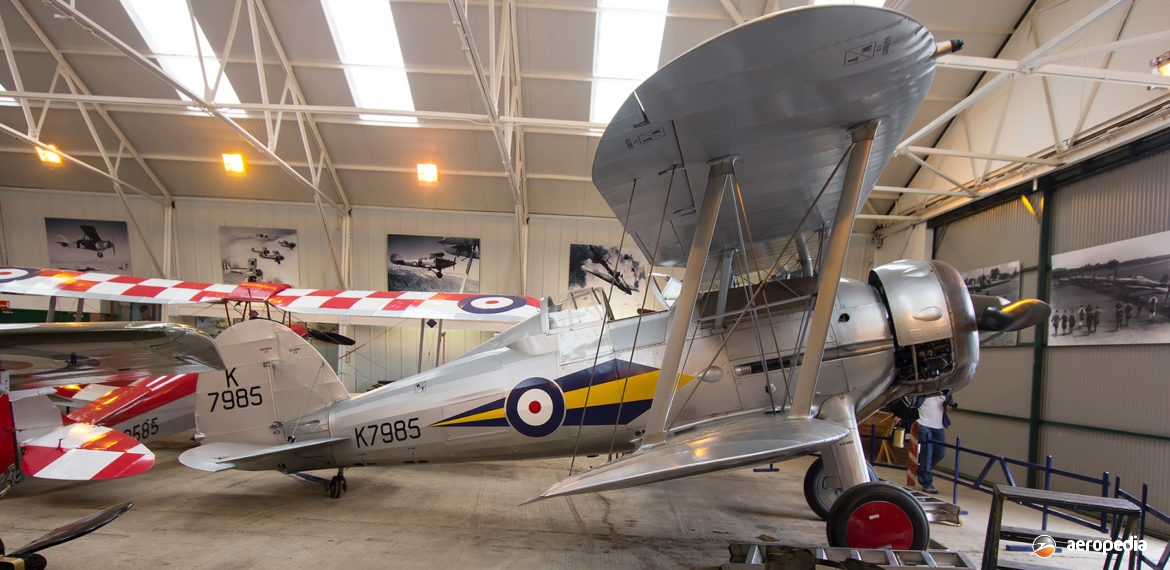Photograph:
Gloster Gladiator K7985 part of the Shuttleworth Collection in the United Kingdom in 2012 (Steve Veigel)
Country of origin:
United Kingdom
Description:
Single-seat fighter biplane
Power Plant:
One 629 kw (840 hp) Bristol Mercury IX nine-cylinder air-cooled radial engine
Specifications:
- Wingspan: 9.84 m (32 ft 3 in)
- Length: 8.38 m (27 ft 5 in)
- Height: 3.17 m (10 ft 4 in)
- Wing area: 30 m² (323 sq ft)
- Max speed at 4,420 m (14,500 ft): 407 km/h (253 mph)
- Cruising speed: 338 km/h (210 mph)
- Initial rate of climb: 701 m/min (2,300 ft/min)
- Service ceiling: 10,058 m (33,000 ft)
- Endurance: 2 hours
- Empty weight: 1,655 kg (3,450 lb)
- Loaded weight: 2,155 kg (4,750 lb)
Armament:
Four 7.7 mm (0.303 in) Browning fixed forward-firing machine guns
History:
The Gloster Gladiator was the last single-engine biplane fighter built for the Royal Air Force (RAF) and, although obsolescent by the commencement of World War II, it enjoyed some success. Designed by a team led by Henry Philip Folland, it was an extensively refined development of the Gauntlet.
The prototype (K5200) was powered by a 481 kw (645 hp) Bristol Mercury VIS radial engine and was armed with two Vickers and two Lewis machine guns, flying for the first time in September 1934. The first batch of 23 Gladiators was ferried to RAF Fenton in Yorkshire in January 1937, entering service with No 72 Squadron.
The type was successful initially in the Middle East and North Africa. New production aircraft received a number of modifications, the Mercury IX and its wooden propeller being replaced by either the Mercury VIII or VIIIA with a three-blade Fairey fixed-pitch propeller, thus becoming the Mk II. The first RAF unit in the theatre was No 80 Squadron in May 1938, being tasked with the defence of the Suez Canal.
In 1937 the Royal Navy (RN) found it was short of a dedicated carrier-borne fighter and it was to be some time before the Blackburn Skua and Fairey Fulmar would become available. A naval variant of the Gladiator was provided, being Mk II airframes taken from the Hucclecote production line, the first aircraft being completed in December 1938. Four carried out sea trials on ‘HMS Courageous’ in March 1939 and six embarked with No 801 Squadron in May that year. In September 1939 a batch of 18 Sea Gladiators was sent to Malta.
On 3 September 1939 Britain announced it was at war, and at that time four front-line squadrons (Nos 603, 605, 607 and 615) at Turnhouse, Tangmere, Usworth and Kenley, being Royal Auxiliary Air Force (RauxAF) squadrons, still operated the type. In November a number went to France as part of the British Expeditionary Force. Examples were exported to Latvia, Lithuania, China, Sweden and Belgium.
Gloster Gladiators were part of the equipment of No 3 Squadron Royal Australian Air Force ( RAAF) in North Africa for some months from July 1940 and served in the fighter role until replaced in May 1941 by Hawker Hurricane Mk Is and later Curtiss Tomahawks.
A number of Gladiators have survived, including K8042 at the RAF Museum at Hendon in Greater London; N5518, a Sea Gladiator, at the Fleet Air Arm (FAA) Museum at Yeovilton in Somerset; and L8032/G-AMRK airworthy with the Shuttleworth Trust at Biggleswade.
In later times a number of wrecks have been recovered from Lake Lesjaskog and other sites in Norway.

